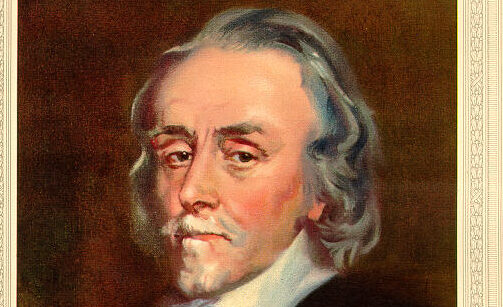
William Harvey (1578-1657) was a renowned English physician who is credited with discovering the circulation of blood. He was born in Folkestone, Kent, England to a wealthy merchant family. Harvey was the eldest of seven children, and he received his early education at the King’s School in Canterbury. He then went on to study at Gonville and Caius College, Cambridge, where he was taught by John Caius, a prominent physician.
After completing his studies at Cambridge, Harvey traveled to Italy to continue his medical education. He attended the University of Padua, where he studied under the famous anatomist Hieronymus Fabricius. It was during his time in Italy that Harvey developed a deep fascination with the human body and its functions, which would eventually lead him to make his groundbreaking discovery.
Harvey returned to England in 1602 and began practicing medicine in London. He was appointed a physician to St Bartholomew’s Hospital in 1609 and became a Fellow of the Royal College of Physicians in 1615. During this time, Harvey gained a reputation as an expert in anatomy and physiology.
Harvey’s most significant contribution to medicine was his discovery of the circulation of blood. Prior to Harvey’s work, it was believed that the heart produced blood, which flowed back and forth between the heart and the liver. However, Harvey’s meticulous dissections and experiments with live animals led him to conclude that the heart was responsible for pumping blood through the body, and that blood circulated in a closed system. This revolutionary idea overturned centuries of medical dogma and paved the way for modern physiology.
Harvey published his findings in his seminal work, “An Anatomical Study of the Motion of the Heart and of the Blood in Animals,” which was published in 1628. The book was initially met with skepticism, but eventually gained widespread acceptance and had a profound impact on the practice of medicine.
In addition to his work on the circulation of blood, Harvey made many other significant contributions to the field of medicine. He conducted extensive research on the nervous system, embryology, and the nature of disease. He was also one of the first physicians to use quantitative methods in medical research.
Throughout his career, Harvey was a respected teacher and lecturer, and he held several prestigious academic positions. He was a physician to both King James I and King Charles I, and he treated many notable patients.
Harvey’s legacy has endured to the present day, and he is widely regarded as one of the most important figures in the history of medicine. His discovery of the circulation of blood was a groundbreaking achievement that changed the course of medical history. His meticulous approach to scientific research has served as a model for generations of medical researchers, and his legacy continues to inspire and influence the field of medicine to this day.
Here’s a timeline of William Harvey’s life and career:
- 1578: William Harvey is born in Folkestone, Kent, England.
- 1593: Harvey begins his education at the King’s School in Canterbury.
- 1597: Harvey enters Gonville and Caius College, Cambridge to study medicine.
- 1602: Harvey leaves Cambridge and travels to Italy to continue his medical education.
- 1609: Harvey is appointed a physician to St Bartholomew’s Hospital in London.
- 1615: Harvey becomes a Fellow of the Royal College of Physicians in London.
- 1616: Harvey is appointed Lumleian Lecturer at the Royal College of Physicians, a position he holds for over 40 years.
- 1628: Harvey publishes his seminal work, “An Anatomical Study of the Motion of the Heart and of the Blood in Animals.”
- 1632: Harvey is appointed Physician-in-Ordinary to King Charles I.
- 1657: William Harvey dies in Roehampton, Surrey, England, at the age of 79.
This timeline highlights some of the key moments in Harvey’s life and career, including his education, his work as a physician and researcher, and his appointment to prestigious academic and royal positions. It also emphasizes his most significant achievement, the discovery of the circulation of blood, which he published in 1628 and which continues to be a foundational concept in modern physiology.
Five interesting facts about William Harvey:
- Harvey was a respected physician to both King James I and King Charles I. He treated many notable patients during his career, including the philosopher Thomas Hobbes.
- Harvey’s discovery of the circulation of blood was initially met with skepticism and resistance from other physicians. It took several years for his ideas to gain widespread acceptance.
- Harvey was one of the first physicians to use quantitative methods in medical research. He conducted extensive experiments and measurements to support his theories about the circulation of blood.
- In addition to his work on the circulation of blood, Harvey made significant contributions to the fields of embryology and neurology.
- Harvey was a lifelong bachelor and had no children. He dedicated himself fully to his medical research and teaching.
And here are five quotes from William Harvey:
- “Nature is nowhere accustomed more openly to display her secret mysteries than in cases where she shows traces of her workings apart from the beaten path.”
- “Nature is the source of all things; it is the teacher of all things.”
- “The human body is a machine which winds its own springs.”
- “Everything is in motion. Everything flows. Everything is subject to the laws of change.”
- “All we know is still infinitely less than all that remains unknown.”










